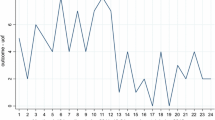Abstract
Law enforcement officers in the USA have one of the highest lethal force rates in the world. A shortcoming of previous research on the use of force is that officer-subject encounters are observed as static events, and not a complex escalation of behaviours. Behaviour sequence analysis can identify common pathways that show chains of behaviours occurring at a level greater than what was expected by chance. The current study used 40 body-worn camera videos of officer-subject interactions leading to either lethal or non-lethal outcomes. The current results show that officers are more likely to use lethal force in response to physical threats from subjects, and likewise, use non-lethal force in response to verbal threats. The outcomes of this research extend to law enforcement and public safety, to understand and potentially reduce use of force incidents, particularly lethal force. It also serves to highlight the dynamic and challenging nature of these interactions to aid in establishing a greater rapport between officers and the communities they serve.


Similar content being viewed by others
Notes
Note, the letter codes for behaviours are relatively arbitrary, “A”, “U” etc. are codes used to make future coding easier and any letter could suffice, as long as each behaviour has a unique code.
Available from corresponding author, on request
Available from corresponding author, on request—they are omitted from publication owing to their size.
The standardized residual is the metric of choice for BSA. It is the measure of difference between the observed and expected frequencies, calculated by the chi-square analysis. The SR gives an indication of which transitions are occurring above the level of chance. A cut-off of SR > 3 is used to make the diagrams clearer to read; full analyses of all transitions are available from the corresponding author on request.
Full diagrams and state transition matrices are available from the corresponding author, on request.
It would be feasibly possible to analyse individual behaviours separately; but, this would make the analyses overly complex and fundamentally change the research question (into what is the effect of multiple officers—an important, but separate issue from the framework the current research is setting).
References
Alpert GP (2015) Police Use of Force. In: Police Use of Force. In international encyclopedia of the Social & Behavioral. Second Edition, Sciences. https://doi.org/10.1016/B978-0-08-097086-8.45073-7
Ariel B, Farrar WA, Sutherland A (2015) The effect of police body-worn cameras on use of force and citizens’ complaints against the police: a randomized controlled trial. J Quant Criminol 31(3):509–535. https://doi.org/10.1007/s10940-014-9236
Bakeman R, Quera V (2011) Sequential analysis and observational methods for the behavioral sciences. Cambridge University Press, New York, NY, US. https://doi.org/10.1017/CBO9781139017343
Bakeman R, Gottman JM (1986) Observing behavior: an introduction to sequential analysis. Cambridge University Press, New York, NY, US
Binder A, Scharf P (1980) The violent police-citizen encounter. The ANNALS of the American academy of political and social science 452(1):111–121
Clarke DD, Crossland J (1985) Action systems: an introduction to the analysis of complex behaviour. Methuen, London
Crow MS, Smykla JO (2019) Police body-worn cameras: research developments on an emerging technology. Crim Justice Rev 44(3):257–262. https://doi.org/10.1177/0734016819854789
Ellis HE, Clarke DD, Keatley DA (2017) Perceptions of behaviours in stranger rape cases: a sequence analysis approach. J Sex Aggress 23(3):328–337. https://doi.org/10.1080/13552600.2017.1361618
Garner JH, Schade T, Hepburn J, Buchanan J (1995) Measuring the continuum of force used by and against the police. Crim Justice Rev 20(2):146–168. https://doi.org/10.1177/073401689502000204
Garner J, Maxwell C (1999) Measuring the amount of force used by and against the police in six jurisdictions. Use of Force by Police, Overview of National and Local Data, pp 25–44
Karlsson I, Christianson SÅ (2003) The phenomenology of traumatic experiences in police work. Policing 26(3):419–438. https://doi.org/10.1108/13639510310489476
Keatley DA (2018) Pathways in crime: an introduction to behaviour sequence analysis. Palgrave Macmillan, London
Keatley DA, Barsky AD, Clarke DD (2016) Driving under the influence of alcohol: a sequence analysis approach. Psychol Crime Law 23(2):135–146. https://doi.org/10.1080/1068316X.2016.1228933
Keatley DA, Marono A, Clarke DD (2018) Unmaking a murderer: behaviour sequence analysis of false confessions. Psychiatry Psychol Law 25(3):425–436. https://doi.org/10.1080/13218719.2018.1463875
Lum C, Stoltz M, Koper CS, Scherer JA (2019) Research on body-worn cameras: what we know, what we need to know. Criminology and Public Policy 18(1):93–118. https://doi.org/10.1111/1745-9133.12412
Magnusson M. S., Burgoon J. K., & Casarrubea, M. (Eds.). (2016). Neuromethods: Vol. 111. Discovering hidden temporal patterns in behavior and interaction: T-pattern detection and analysis with THEME™. Totowa, NJ, US: Humana Press. https://doi.org/10.1007/978-1-4939-3249-8
Magnusson M. S. (2000). Discovering hidden time patterns in behavior: T-patterns and their detection. behavior research methods, instruments, and computers, 32(1), 93–110. https://doi.org/10.3758/BF03200792
Marono A, Clarke D, Navarro J, Keatley D (2018) A sequence analysis of nonverbal behaviour and deception. J Police Crim Psychol 33(2):109–117. https://doi.org/10.1007/s11896-017-9238-9
Miller L, Toliver J (2014) Implementing a body-worn camera program: recommendations and lessons learned. Police Executive Research Forum 2014
National Institute of Justice (2009). The use-of-force continuum. Retrieved from https://www/nij/gov/topics/law-enforcement/officer-safety/use-of-force/Pages/continuum.aspx
Prenzler T, Porter L, Alpert GP (2013) Reducing police use of force: case studies and prospects. Aggress Violent Behav 18(2):343–356. https://doi.org/10.1016/j.avb.2012.12.004
R Core Team. (2013). R: a language and environment for statistical computing. R Foundation for Statistical Computing, Vienne, Austria. ISBN 3–900051–07-0, URL http://www.R-project.org/
Shane JM, Lawton B, Swenson Z (2017) The prevalence of fatal police shootings by U.S. police, 2015–2016: patterns and answers from a new data set. J Crim Just 52:101–111. https://doi.org/10.1016/j.jcrimjus.2017.05.001
White MD (2002) Identifying situational predictors of police shootings using multivariate analysis. Policing: an international journal of police strategies & management 25(4):726–751. https://doi.org/10.1108/13639510210450659
Author information
Authors and Affiliations
Corresponding author
Ethics declarations
Conflict of Interest
The authors declare that they have no conflict of interest.
Ethical Statement
This article does not contain any studies with human participants performed by any of the authors.
Informed Consent
N/A
Additional information
Publisher’s Note
Springer Nature remains neutral with regard to jurisdictional claims in published maps and institutional affiliations.
Rights and permissions
About this article
Cite this article
Longridge, R., Chapman, B., Bennell, C. et al. Behaviour Sequence Analysis of Police Body-Worn Camera Footage. J Police Crim Psych 38, 255–262 (2023). https://doi.org/10.1007/s11896-020-09393-z
Published:
Issue Date:
DOI: https://doi.org/10.1007/s11896-020-09393-z




